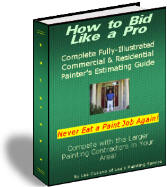Spray
painting is a valuable painting tool that saves you both time and
money. With a spray rig you can turn your jobs in days instead of
weeks.
When And Why Spray?
If you want to paint new construction, decks, exterior siding, rough
surfaces, etc. you can make a lot more money because you can turn your
jobs faster compared to brushing and rolling. Spraying irregular
surfaces like decks and lattice make spray painting a super fast method.
 Spraying is:
Spraying is:
- About 4 times faster than brushing.
- Two times faster than rolling.
- Spraying offers uniform coverage. It evenly
applies over smooth and
rough surfaces.
- You can add accessories where needed to save
even more time.
- You can spray most common coatings and even use
a rolling attachment
if back rolling is needed.
How To Choose The
Right Size Sprayer Unit
The companies that make spraying equipment will say:
- How often will you be using it?
- How many gallons a year will you spray?
- What types of coatings will you use?
But a painting contractor will tell you to buy a smaller spray unit for
stains and varnishes and a medium size or larger unit for interior
spraying, rolling and for exterior use.
With a large sprayer you will be able to use the largest spray tip
which gives the largest fan of spray and delivers the most paint
coverage. A medium sprayer may only be able to use a mid-range of spray
tips, which won’t be quite as wide of a spray fan.
Also it depends on what jobs come your way. If it’s a light job using
stains, go with a small airless paint sprayer first. Use your down
payment to buy it and
let the job pay it off.
Instructions
Will
Guide You The Rest Of The Way
Your owner’s manual and possible DVD will show you how to run your new
spray rig. It will also tell you about “spray tip life”, and which
coatings to use for each spray tip.
An airless paint sprayer is basically just a pump, airless hose and a
spray gun. The paint is pumped through to the spray gun and forced
through the spray tip, which produces various spray pattern fans
depending on the tip and the material being sprayed.
The Neatest Thing
About Airless Spray Painting Is That It Produces Hardly Any
Over Spray.
Since no air is used to force the paint out, there is very little
over-spray and the air in the room is not filled with paint fumes. The
same advantage goes for exterior spraying as well.
Once you buy your spray system the owner’s manual will show you which
spray tip to use for each type of coating, what the tip life is, how
much pressure to use etc.
Gas Powered Vs
Electric
Some spray rigs are “gas powered”. You will probably want to stay with
the more common electric powered sprayer. That way you can use it
indoors, and it will be less noisy as well.
Extra
Equipment
You Will Need
- A 5-gallon bucket to mix all your paint
together in, (boxing), so you
have the same tint color throughout the job.
- Masking tape, rolls of paper and painters
plastic to mask off areas not being painted.
- A shield (keeps spray away from certain areas
when spraying).
- A respirator or spray mask.
- A baseball cap and a long sleeve shirt.
- A "tip extension" and/or heavy-duty extension
for the gun. (These
screw onto the gun allowing you extended reach without needing a
ladder (can speed up painting process even more).
- There are pressure roller kits and extensions
as well if needed.
- Your manual will show you how to paint and how
to spray. (Basically
you mix all your paint into the 5-gallon pail (called boxing), insert
the dip tube from the pump into the bucket, and make sure all your
fittings are tight.)
More Spray Painting Tips
- Use rolls of maskting tape, paper and plastic
sheeting to block out
areas not to be painted.
- Use a shield to also block areas while spraying.
- Don't spray in people's homes or offices. If
you have a lot of
continuous wall space to roll out use a power roller attachment.
- Lightly cover plants and schrubs when painting
around them.



